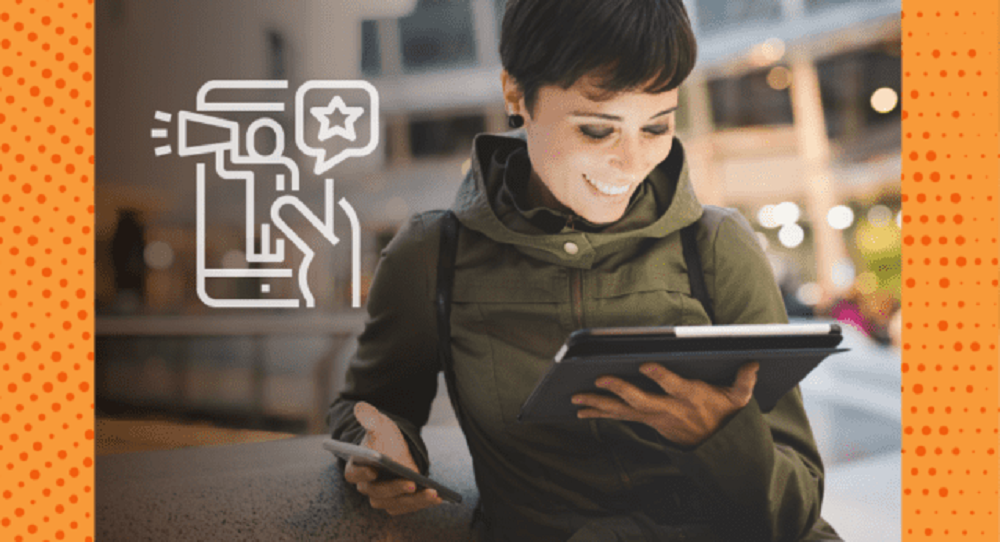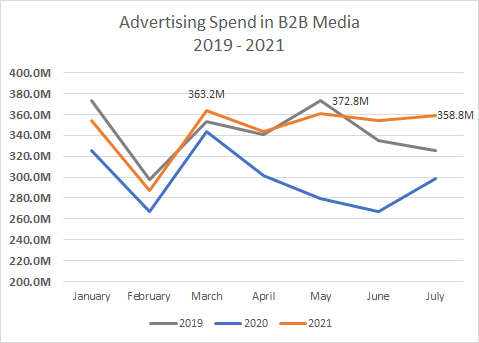
Between account-based marketing plans, in-app messaging, social media and content across channels, digital marketing is a lot to handle for B2B companies who are still fairly new to the space.
According to MediaRadar data, there were 22.7k new digital advertisers in the B2B space between January 2019 and June 2021, with more than half currently active.
Marketers aren’t only investing in digital ad placements. They are using their budget to work with influencers.
Here, we dive into the overall status of B2B digital marketing, plus what’s taking shape with B2B influencers.
B2B advertising spending is above 2019 levels
B2B companies are back at it.
Overall B2B ad spend is up 16% year-over-year. And even when we look at 2019, we see improvements.
In July 2021, we found that brands spent 10% more on advertising than they did during the month of July 2019. This includes both print and digital media.

Unsurprisingly, digital ad spending is a driving force in the return of B2B buying. Total B2B ad spend in 2021 (January – July) is $2.4bn, of which $1.28bn is digital.

In 2021 (January – July), B2B digital advertising is up 73% over 2020 and 118% over 2019. July 2021 marked the highest month of digital advertising spend in B2B media, where 56% of spend was dedicated to digital ad space.
While brands are investing specifically in digital ads across podcasting, native, OTT, programmatic and more, they are also investing in partnerships with influencers, a strategy typically employed by B2C brands.
B2B brands experiment with new influencer strategies
As brands shifted to digital advertising, they also began to try out influencer marketing.
In the B2C world, influencer marketing has been around for a while. Brands pay influencers or celebrities to do a sponsorship post or participate in an entertaining campaign.
In the B2B landscape, executives typically become social media influencers by curating thought leadership content. In this way, they develop trust with their potential customers and become a perceived authority in their industry.
While Twitter and LinkedIn tend to be the most popular social channels for B2B influencers, B2B brands have been breaking into TikTok and seeing success.
Using TikTok, brands are trying new ways to take advantage of influencers in micro-communities. For example, Adobe will feature artists who use the software, turning their creative work into a TikTok tutorial.
“There’s an old rule of thumb that consumer brands lead with entertainment, while B2B brands lead with education,” explained Lauren Silverman, group strategy director at Doremus, Omnicom’s B2B marketing agency, to AdAge. “Usually, educating consumers can be a higher barrier to get them interested, but B2B brands are finding ways to make that education entertaining.”
B2B buyers spend nearly 27% of their time researching products independently online, compared to the 17% of their time meeting with suppliers. Because of this, it’s critical to have helpful and educational content about a product—but it’s even more effective for that information to be interesting.
Influencer marketing simply feels more human and engaging.
Digital ads and influencer marketing have distinct differences. Ads have consistent messaging, while the influencer’s voice will play a part in the creative. Programmatic placements are placed within milliseconds, but becoming a trustworthy influencer can take years. Shifting an ad campaign from print to digital might feel somewhat natural, while identifying up and coming influencers will take more research and creativity.
Because of their differences, the two go hand in hand for building a brand and converting more accounts. As digital advertising and influencer marketing grow in the B2B space, we hope to identify brands and leaders who pull together their cross-channel strategies well and highlight them here.
To learn more about the data behind this article and what MediaRadar has to offer, visit https://mediaradar.com/.







Sign up to receive our stories in your inbox.
Data is changing the speed of business. Investors, Corporations, and Governments are buying new, differentiated data to gain visibility make better decisions. Don't fall behind. Let us help.













Sign up to receive our stories in your inbox.
Data is changing the speed of business. Investors, Corporations, and Governments are buying new, differentiated data to gain visibility make better decisions. Don't fall behind. Let us help.





